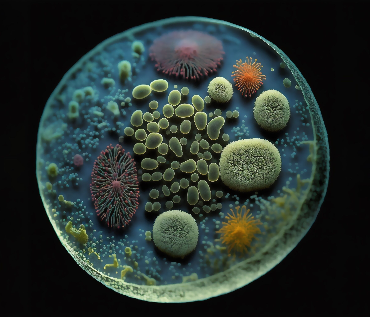Table Of Contents
5. Why does Image Filtering hold the utmost importance in Image Processing?
6. Why does Edge Detection act as a fundamental step in Image Processing Applications?
7. Which are the most commonly used Image Filtering online tools?
8. Which Image Filtering Techniques are used in the Pharmaceutical Industry?
9. What are the recent advances in Image Filtering Techniques
10. Which trends are likely to influence the future of Image Filtering?
Introduction
When discussing image processing, the term "image filtering techniques" refers to a group of procedures or algorithms used to alter or improve digital pictures by changing their pixel values. These methods include applying different mathematical operations or filters to an image to accomplish particular goals including noise reduction, picture sharpening, blurring, edge detection, and feature extraction.
In this article, we are going to learn about the different techniques of image filtering, what is the importance of image filtering, which image filtering tools are utilized generally, and much more. Having a clear understanding of all these techniques is considered to be important for tasks such as noise reduction and edge detection, which offers a solid foundation for applying image processing in different technologies. Now, let’s dive right into the article!
What Is Image Processing?
Image processing is a term that is used to define the analysis of images via different methods. It involved the utilization of computational techniques and algorithms so that different operations can be conducted such as improving their quality, identifying patterns, and extracting information.

What Is Meant By Image Filtering?
Image filtering is a technique that is utilized in image processing to enhance or revise the visual appearance of the image. Image filtering encompasses using a filter/kernel for every pixel in an image so that a new pixel value can be acquired based on the values of the existing pixels. Here, the filter helps in defining the weights that have been applied to the neighboring pixels at the time of the filtering method.
What Are The Most Frequently Employed Image Filtering Techniques?
I. The Gaussian Filter: The Gaussian filter is a common smoothing filter that blurs and eliminates noise by convolving the picture with a Gaussian function.
II. Median Filter: The median filter replaces each pixel's value with the median value of its neighborhood. It is a non-linear filter. It successfully eliminates impulsive noise, sometimes known as "salt and pepper" noise, from a picture.
III. Bilateral Filter: The bilateral filter soothes a picture while keeping crucial edges. It is a non-linear, edge-preserving filter. When determining the filter weights, it takes both spatial distance and pixel intensity similarity into account.
IV. Sobel Operator: The Sobel operator computes an image's gradient and is an edge detection filter. It is frequently used to draw attention to steep gradients on edges.
V. The Laplacian of Gaussian (LoG): This filter combines the Laplacian and Gaussian filters. The Laplacian of the Gaussian function is convolved with an image to improve edges while lowering noise.
VI. High-Pass Filters: High-pass filters emphasize an image's edges and fine details by enhancing its high-frequency components. The Laplacian filter and the unsharp mask filter are two examples.
VII. Low-Pass Filters: Low-pass filters smooth or blur a picture by reducing the high-frequency components of the image. Examples of low-pass filters are the Gaussian and mean filters.
VIII. Morphological Filters: Based on the ideas of mathematical morphology, morphological filters are utilized for processes including erosion, dilation, opening, and closure. These filters work well at eliminating background noise, bridging holes, and separating related items.
IX. Anisotropic Diffusion: This method is utilized for edge-preserving smoothing and picture denoising. It blurs pixel values while keeping an image's important edges.
X. Adaptive Filters: Adaptive filters modify their settings according to the specifics of the local picture. They are helpful in situations when an image's spatial qualities fluctuate.
These are but a handful of examples of typical image processing methods for image filtering. The selection of the right filter relies on the particular image processing task and the intended result since each approach has its unique properties and uses.

Why Does Image Filtering Hold The Utmost Importance In Image Processing?
The following are a few significant reasons why image filtering is crucial in image processing:
1) Noise Reduction — Unwanted noise, such as random changes in pixel values, frequently accompanies images taken by cameras or produced by digital processes. Noise may be successfully reduced or eliminated using picture filters, creating images that are clearer and more appealing to the eye.
2) Smoothing And Blurring — Using image filters to smooth or blur a picture diminishes abrupt transitions and minute details. Applications like picture denoising, spot removal, and aesthetic effects can all benefit from this.
3) Edge Detection — Edge detection image filters highlight the borders separating various areas or objects in a picture. In processes like object identification, picture segmentation, and feature extraction, edges must be detected.
4) Image Enhancement — Filters may bring out particular details or qualities in an image. For instance, sharpening filters can enhance the sharpness and definition of edges, giving the appearance of greater detail in the image. By increasing the visual contrast between various components in the image, contrast enhancement filters can make some parts of the scene stand out more.
5) Aesthetic Alterations — Image filtering may also be employed for aesthetic reasons, enabling photographers, designers, and artists to alter the look of their photos to create a certain visual aesthetic or emotional state. Filters can be used to produce artistic alterations, replicate film effects, and create retro aesthetics.
Image filtering, in general, plays a critical part in image processing by boosting key characteristics, lowering noise, and putting pictures in a state that is ready for further analysis or visual display. It makes it easier to read and comprehend visual data, and it aids in achieving desired results in a variety of applications.

Why Does Edge Detection Act as A Fundamental Step In Image Processing Applications?
Image processing edge detection is the act of locating and emphasizing the boundaries or edges of objects inside an image. The structure and characteristics contained in an image may be inferred from edges, which show notable changes in intensity or color values.
Many image processing applications, such as object identification, picture segmentation, and feature extraction, start with edge detection. In image processing, edge detection may be accomplished using a variety of methods.
Here are a few that are regularly employed:
a) Methods Based On Gradients: By computing the gradient (rate of change) of intensity values in a picture, these techniques identify edges. The Sobel, Prewitt, and Roberts operators are among the most widely used gradient-based edge detection techniques. To locate areas of sudden changes in intensity, these operators compute the gradient's magnitude and direction.
b) Laplacian-Based Techniques: By calculating the second derivative of intensity values, laplacian operators, such as the Laplacian of Gaussian (LoG), identify edges. Edges in a picture are represented as regions with a zero crossing by the Laplacian operator.
c) Canny Edge Detection: A popular method for locating the best edges while reducing noise and false detections is the Canny edge detection algorithm. It entails several processes, such as hysteresis thresholding, non-maximum suppression, gradient computation, and Gaussian smoothing.
d) Wavelet-Based Techniques: Wavelet transformations may be used to detect edges by examining an image's frequency content. Edges are found using wavelet-based methods like the Wavelet Transform Modulus Maxima (WTMM) approach by locating significant local maxima in the wavelet transform.
e) Hough Transform: The Hough transform is a method for identifying parametric forms such as straight lines, curves, and other shapes in an image. By converting the picture space into a parameter space and looking for peaks that match edge characteristics, it may be used to identify edges.
It's crucial to remember that edge detection algorithms may yield poor results, and the choice of approach depends on the attributes of the picture and the particular application needs. To obtain accurate and dependable edge detection findings, several edge detection approaches are frequently combined with the subsequent post-processing processes in practice.
Which Are The Most Commonly Used Image Filtering Online Tools?
There are several image-filtering online programs and websites that provide picture-filtering functionality.
Here are a few well-liked choices:
a) Pixlr
A web-based application for modifying images, Pixlr offers a variety of filters and effects. It provides both fundamental and sophisticated capabilities, such as different filters, tweaks, and artistic effects. To get the desired appearance, submit your photograph to the website and use various filters.
b) Fotor
Fotor is an additional online photo-editing tool with a large selection of filters and effects. You may upload your image, add filters, change settings, and improve your images with this tool. Additionally, Fotor offers editing capabilities including cropping, resizing, and retouching.
c) LunaPic
Several filters and effects are available in this online image editor. You may upload your photo and add effects like sepia, vintage, blur, and others. LunaPic also provides other picture editing features including cropping, scaling, and text insertion.
d) BeFunky
A variety of filters and effects are offered by this online picture editor. It has an intuitive user interface that enables you to upload images and edit them with different filters and settings. Additional editing tools offered by BeFunky include cropping, scaling, and the addition of text or overlays.
e) PhotoFilters.com
This straightforward web application is designed to add filters to photos. It provides a selection of filters that may be used on the image you provide. Before adding the filters to your image, you may preview them and choose their strength.
These are but a few samples of internet programs that provide picture filtering. To select the tool that best meets your demands in terms of available filters, user interface, and additional editing tools, it's always a good idea to investigate and contrast several possibilities.

Which Image Filtering Techniques Are Used In The Pharmaceutical Industry?
The pharmaceutical business uses several noise-reduction and information-extracting image-filtering algorithms to improve image quality.
In the pharmaceutical sector, the following image-filtering methods are frequently used:
I. Gaussian Filtering: A common method for decreasing noise and smoothing out photographs is Gaussian filtering. It blurs the image and reduces high-frequency noise by applying a weighted average to each pixel in the image. In microscope pictures or medical imaging data, gaussian filtering is effective for improving image quality and lowering noise.
II. Median Filtering: When used to remove impulsive noise or salt-and-pepper noise from pictures, median filtering is especially successful. It successfully preserves edges and fine features while decreasing noise by replacing each pixel with the median value found within its nearby neighborhood. To increase the accuracy of image analysis and inspection systems, median filtering is frequently used in pharmaceutical quality control operations.
III. Wiener Filtering: This deconvolution method restores pictures that have been blurred or distorted by noise. Based on an understanding of the process of deterioration and the characteristics of the noise, it employs a statistical method to estimate the original image. To increase picture resolution and clarity, Wiener filtering is utilized in medical imaging and pharmaceutical microscopy.
IV. Anisotropic Diffusion: This filtering approach reduces noise while maintaining the edges and features of images. While keeping distinct borders and smooth zones, it diffuses noise in such areas. Anisotropic diffusion improves the imaging of pharmaceutical samples or particles by lowering noise and maintaining key details.
V. Homomorphic Filtering: This technique is used to improve photos with different degrees of light. Separating the lighting and reflectance components of a picture helps rectify uneven illumination, changes in shadows, and highlights. When uniform light is important, homomorphic filtering is beneficial in pharmaceutical microscopy and imaging applications.
VI. Morphological Filtering: Morphological filtering enhances or suppresses particular aspects of pictures by using mathematical morphology operations including erosion, dilation, opening, and closure. In pharmaceutical applications involving shape analysis, particle size distribution, or morphological characterization, it is very helpful.
These are just a few instances of image-filtering methods that are often employed in the pharmaceutical sector. The kind of filtering technique used will rely on the characteristics of the pictures, the kind of noise or artifacts present, and the desired image analysis or enhancement objectives.
To attain the necessary picture quality and analytical results, several filtering method combinations may also be used. Companies like ImageProVision offer smart proofreading systems that provide pixel-to-pixel comparison-based identification solutions for cartons, leaflets, and label analysis.
What Are The Recent Advances in Image Filtering Techniques?
There have been some significant improvements and advancements in the area of image-filtering algorithms in recent years.
Here are a few significant areas of development:
1) Deep Learning-Based Filters: Convolutional neural networks (CNNs), a kind of CNN, have revolutionized image filtering. Researchers have created CNN-based filters that are remarkably accurate and effective at completing tasks including image denoising, super-resolution, and picture enhancement. These filters use massive training datasets to learn how to extract intricate details from the photos.
2) Generative Adversarial Networks (GANs): GANs have demonstrated potential in the field of image filtering. GANs are made up of a discriminator network that tries to tell the difference between genuine and fake pictures and a generator network that creates synthetic images. Researchers have obtained outstanding results in tasks like picture denoising, inpainting, and style transfer by training GANs on big datasets.
3) Joint Image Filtering: During the filtering process, joint image filtering algorithms take into account numerous input pictures or other information. For instance, depth-aware filters use depth data to direct filtering and maintain depth-dependent features. Joint filters have proven useful for projects like depth-guided picture improvement, depth-aware deblurring, and depth-image-based rendering.
4) Edge-Preserving Filters: Computational efficiency and performance improvements have been made to edge-preserving filters. Important edges are intended to be preserved while noise is reduced or other parts of the picture are enhanced with these filters. Recent advancements include faster algorithms, methods for adaptive filtering, and interaction with deep learning frameworks.
5) Multi-Scale Filters: Multi-scale filtering methods are increasingly popular since they can collect visual data at many scales. These filters carry out filtering operations at several pyramidal or resolution levels, enabling a thorough examination of picture structures. Edge identification, texture enhancement, and picture segmentation are a few examples of jobs where multi-scale filters have been effective.
These are but a few examples of current advances in image filtering methods. As a result of ongoing research aimed at enhancing the caliber, effectiveness, and adaptability of image filtering algorithms, the area of image processing is continually changing.

Which Trends Are Likely To Influence the Future of Image Filtering?
Advancements in many important areas are anticipated to significantly impact the future course of image-filtering approaches.
Here are some possible paths and trends that might affect the trajectory of image filtering in the future:
A) Filters Based On Deep Learning: Deep learning has already significantly improved image filtering and this development is anticipated to continue. Further study will concentrate on creating more specialized and effective architectures that can manage particular picture properties and achieve even greater performance.
B) Automation And Autonomous Systems: As automation and autonomous systems proliferate, image-filtering techniques will become increasingly important in facilitating rational analysis and decision-making. Intelligent surveillance systems, autonomous cars, and robotics will require advanced filtering techniques to improve image quality, identify useful characteristics, and deliver accurate information.
C) Mobile And Real-Time Applications: There is a rising need for real-time image filtering on mobile devices, in augmented reality (AR) applications, and embedded systems. Future image-filtering methods will concentrate on creating effective algorithms and models that can deliver high-quality filtering outcomes in real time while taking into account the constrained processing capabilities and power restrictions of embedded and mobile systems.
These developments portend an era in which image-filtering methods will advance in complexity, adaptivity, and effectiveness, opening up a wide range of applications in many fields.
As academics investigate novel architectures, algorithms, and integration strategies to address the difficulties and opportunities in image processing and analysis, the discipline will continue to develop.
Summing It Up
In conclusion, having a clear understanding of image filtering techniques empowers researchers, practitioners, or even engineers to harness the transformative capabilities of image processing. As we continue to push the boundaries of what is achievable in this dynamic field, the mastery of image filtering remains a foundational skill, and it is considered essential for those who are seeking to take out meaningful insights and unlock the true potential of digital imagery.




